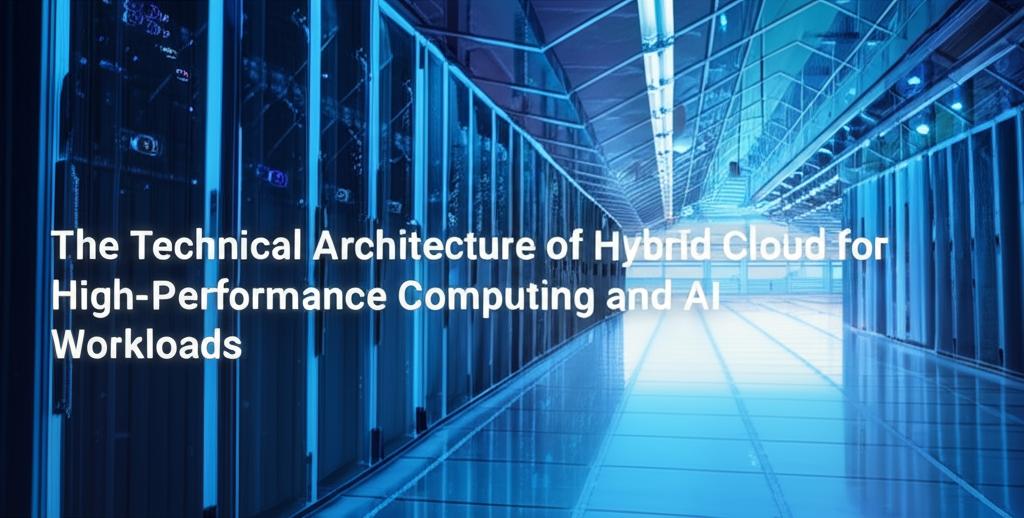Hybrid cloud represents a fusion of private cloud infrastructure (often on-premises data centers) with public cloud services, operating together as a single, flexible computing environment. This model is increasingly vital for High-Performance Computing (HPC) and Artificial Intelligence (AI) workloads due to their demanding nature, requiring immense computational power, massive datasets, and specialized hardware, often exceeding the capacity or cost-effectiveness of solely on-premises or public cloud solutions.
Core Architectural ComponentsA successful hybrid cloud architecture for HPC and AI hinges on several key components working in concert:
- Compute Resources: This involves a mix of traditional CPUs alongside specialized accelerators like Graphics Processing Units (GPUs), Tensor Processing Units (TPUs), and Field-Programmable Gate Arrays (FPGAs), essential for parallel processing in HPC simulations and accelerating AI model training and inference. The architecture must allow workloads to access the appropriate compute resources whether they reside on-premises or in the public cloud.
- Storage Solutions: Managing vast datasets generated and consumed by HPC and AI is critical. Hybrid architectures often employ tiered storage strategies. Sensitive or frequently accessed data might remain on-premises for security, compliance, or low-latency access, while large archival datasets or less sensitive information can leverage cost-effective public cloud storage. High-performance file systems (like Lustre, GPFS/Spectrum Scale alternatives like WEKA) capable of spanning both environments are often necessary to ensure seamless data access.
- Networking Fabric: High-bandwidth, low-latency connectivity between the private and public cloud components is paramount. Technologies like VPNs establish secure connections, but often dedicated interconnects (e.g., AWS Direct Connect, Azure ExpressRoute, Google Cloud Interconnect) are required to handle the large data transfers typical of HPC/AI workloads without bottlenecks. Network optimization is key.
- Management and Orchestration Layer: A unified control plane is essential for managing resources and deploying workloads across the hybrid environment consistently. Containerization technologies (like Docker) and orchestration platforms (primarily Kubernetes) are widely adopted. Tools like Google Cloud Anthos, Azure Arc, AWS Outposts, VMware Cloud Foundation, and Red Hat OpenShift help manage applications and infrastructure seamlessly across diverse environments, simplifying deployment and ensuring consistency.
The hybrid model offers specific advantages for these demanding workloads:
- Scalability and Elasticity ("Cloud Bursting"): Handle peak demands or large-scale experiments by dynamically scaling out to public cloud resources when on-premises capacity is insufficient. This avoids overprovisioning expensive local hardware.
- Access to Specialized Hardware: Leverage cutting-edge GPUs, TPUs, or other accelerators available in public clouds without the upfront investment and maintenance overhead, often on a pay-as-you-go basis.
- Cost Optimization: Balance costs by running steady-state workloads on potentially cheaper (over the long term) on-premises infrastructure while using the public cloud's pay-per-use model for intermittent, large-scale, or specialized tasks. AI-driven tools can help optimize workload placement for cost and performance.
- Data Sovereignty and Security: Keep sensitive data within the private cloud or on-premises infrastructure to meet regulatory compliance (like GDPR) or internal security policies, while still utilizing public cloud compute for processing.
- Flexibility and Agility: Choose the optimal environment for specific stages of a workflow. For example, data preparation might occur on-premises, model training in the public cloud using powerful GPUs, and inference at the edge or back on-premises for low latency.
- Accelerated Innovation: Enable researchers and data scientists access to the latest tools, AI platforms, and computing architectures offered by public cloud providers, fostering faster experimentation and development cycles.
Building an effective hybrid architecture for HPC and AI requires careful planning:
- Workload Assessment and Placement: Analyze the specific requirements of each workload (compute intensity, data sensitivity, latency needs, dependencies) to determine the best placement strategy across the hybrid environment.
- Data Management Strategy: Define clear policies for data movement, synchronization, storage tiering, and access control across environments. Data locality and minimizing large data transfers are crucial for performance and cost.
- Consistent Security Posture: Implement unified security policies, identity management, and monitoring across both private and public clouds. Zero-trust architectures are becoming increasingly important.
- Seamless Integration and Automation: Utilize APIs, orchestration tools, and potentially Infrastructure as Code (IaC) practices to automate deployment and management across the hybrid landscape. Integrating CI/CD pipelines is a best practice.
- Performance Monitoring and Optimization: Implement observability tools that provide visibility across the entire hybrid stack to monitor performance, identify bottlenecks, and optimize resource utilization and costs.
The hybrid cloud landscape for HPC and AI continues to evolve:
- AI-Driven Operations: Using AI/ML to automate resource allocation, optimize workload placement for cost and performance, predict resource needs, and enhance security monitoring.
- Edge Computing Integration: Extending the hybrid model to include edge locations for processing data closer to its source, reducing latency for real-time AI inference and IoT applications.
- Heterogeneous Computing: Increasingly complex systems combining CPUs with diverse accelerators (GPUs, FPGAs, TPUs) managed cohesively across the hybrid environment.
- Containerization and Serverless: Growing use of containers (Kubernetes) for application portability and serverless functions for specific event-driven tasks within the hybrid framework.
- Sustainability Focus: crescente attenzione all'efficienza energetica nei data center on-premise e alla scelta di provider di cloud pubblico con iniziative di sostenibilità. [Increased focus on energy efficiency in on-premises data centers and choosing public cloud providers with sustainability initiatives.]
Despite the benefits, challenges remain:
- Complexity: Managing disparate environments, tools, and security policies requires significant expertise.
- Data Governance and Compliance: Ensuring consistent data handling and compliance across different jurisdictions and environments.
- Network Dependency: Performance heavily relies on the quality and bandwidth of the network connecting the environments.
- Cost Management: While potentially optimizing costs, poor management can lead to unexpected expenses from data egress fees or inefficient resource usage.
- Vendor Lock-in: Potential dependency on proprietary technologies from specific cloud providers.
In conclusion, a well-architected hybrid cloud provides a powerful and flexible foundation for computationally intensive HPC and AI workloads. It allows organizations to balance performance, cost, security, and scalability by strategically combining on-premises infrastructure with public cloud resources. Success requires careful planning around workload placement, data management, networking, security, and leveraging appropriate orchestration and management tools to bridge the different environments effectively.

